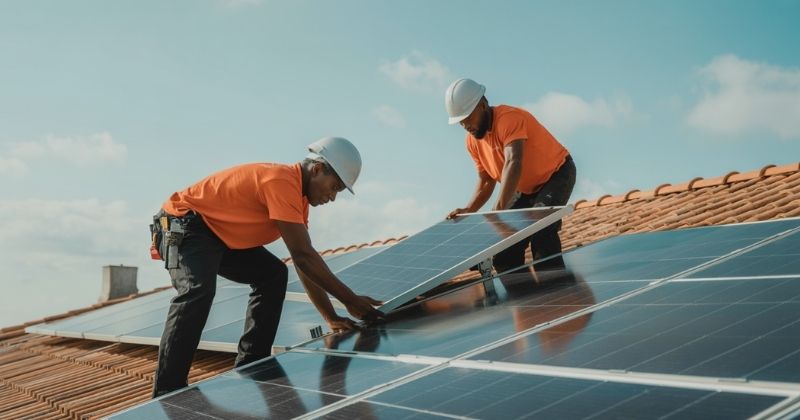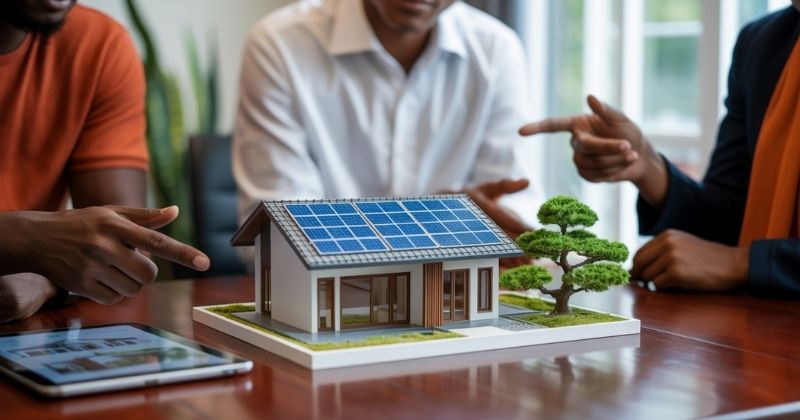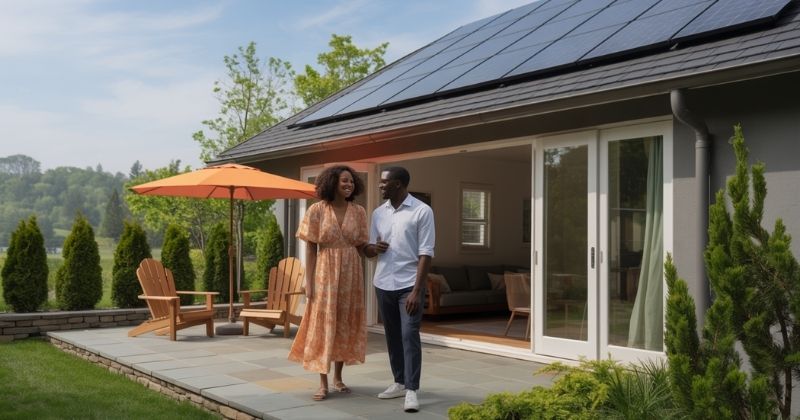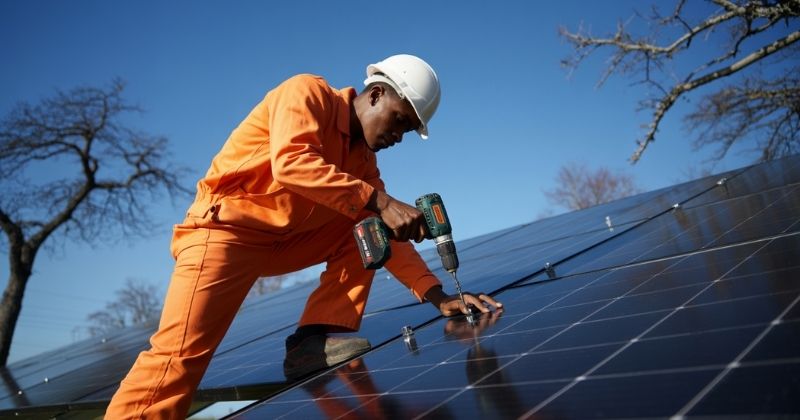
Eskom has officially announced that it will begin making use of advanced satellite surveillance technology to identify solar systems that have not been registered in accordance with national regulations, warning homeowners across South Africa to verify the compliance and registration status of their solar installations without delay. It marks a sharp shift from Eskom’s previous hands-off approach, signalling the utility’s intent to crack down on what it sees as a growing threat to grid revenue and operational control.
Key Takeaways
- Satellite Tracking of Unregistered Solar Systems: Eskom is using satellite technology to identify rooftop solar systems that are not registered, with the goal of enforcing compliance and recovering revenue lost from off-grid energy generation.
- Legal and Financial Consequences for Non-Compliance: Homeowners with unregistered or incorrectly installed systems risk fines, disconnection, or retroactive charges. Valid registration, a Certificate of Compliance (CoC), and a registered installer are essential to avoid legal issues and insurance problems.
- Limited-Time Waiver of Registration Fees: Eskom has waived all Small-Scale Embedded Generation (SSEG) registration fees until March 2026, providing an opportunity for homeowners to become compliant without incurring upfront costs.
About Arcadia Finance
Get the loan you need quickly and securely with Arcadia Finance. No application fees, no hassle. Choose from 19 trusted lenders, all fully registered with South Africa’s National Credit Regulator. Reliable options tailored to your financial needs.
Unregistered Solar Systems to Be Identified Through National Satellite Scans
In a statement released in May, Eskom confirmed its intention to implement a national scan using satellite imaging technology to detect Small-Scale Embedded Generation (SSEG) systems that are operating without the proper authorisation or registration. This move is widely seen as an effort to recover lost income from households generating their own electricity and reducing reliance on the national grid.
Satellite Mapping Will Pinpoint Solar Installations for Cross-Checking
This approach involves the utilisation of sophisticated geographic mapping software in combination with satellite-captured images to locate rooftop solar systems in residential areas. Once detected, these images will be compared against official registration databases to identify any systems that have not been formally registered with the relevant authorities. By leveraging third-party data analytics and geolocation mapping tools, Eskom aims to eliminate loopholes that previously allowed unregistered systems to operate unnoticed.
Due to the fixed requirement that solar panels must be positioned to face the sun directly in order to generate optimal energy output, they are easily detected by satellites capturing overhead imagery. This makes the use of such technology particularly effective for locating solar arrays from space. The high contrast of photovoltaic panels against typical roofing materials also makes them visually distinct, especially in high-resolution imagery used in satellite surveillance.
Why let steep installation bills cloud your sunshine savings? With Flexible Solar Loans you can spread the cost of rooftop panels over manageable monthly repayments.

Energy Sector CEO Says Enforcement Is Set to Intensify
According to Rein Snoeck Henkemans, who serves as the Chief Executive Officer of Alumo Energy, this move clearly signals that Eskom, along with local municipal authorities, is significantly escalating efforts to enforce compliance among households using unregistered solar energy systems. He warned that this is no longer a matter of best practice, but of legal and financial risk, as municipalities are now coordinating with Eskom to launch synchronised inspection efforts.
Snoeck Henkemans explained that both Eskom and the South African government are now placing a much greater focus on tightening compliance regulations for rooftop solar users. This initiative forms part of a broader national enforcement drive that may result in numerous fines being issued to non-compliant solar owners across the country. Industry experts believe that the crackdown could impact tens of thousands of homes, especially in urban areas where solar adoption surged during the height of load-shedding.
Load-Shedding Solar Installations Now Under Scrutiny
Many South African households that hurriedly installed solar systems during periods of severe load-shedding must now ensure that these systems are properly registered and comply with regulatory requirements. Failure to do so could expose homeowners to disconnection from the grid or unexpected charges for the use of the power network. Retrospective charges could stretch into the thousands of rand, especially if authorities determine that solar exports into the grid occurred without proper authorisation.
SSEG Registration Fees Waived Until March 2026
To encourage compliance, Eskom has introduced a temporary measure that waives all registration fees for Small-Scale Embedded Generation systems until the end of March 2026. This initiative is intended to make it easier for solar owners to complete the required registration process during the grace period. This offer may not be renewed, making it a crucial window for homeowners to legalise their systems at minimal cost.
Registration Still Required Despite Fee Waiver
Despite the waiver of fees, Alumo Energy has emphasised that solar users must not ignore their legal obligations. The company has encouraged all users to carry out three important checks to ensure that their systems meet the necessary legal and technical requirements and to avoid facing future penalties. These checks form part of a broader compliance checklist that all system owners should treat as non-negotiable.
Transform your rooftop into a green power hub without emptying your savings. Our Home Improvement Financing option provides the extra boost you need to reinforce roofs, upgrade wiring and install inverters!

How to Determine Whether Your Solar System Needs Registration
To assess whether a particular system must be registered, homeowners are advised to check whether the system is rated under 100 kilowatts and is connected to either Eskom’s infrastructure or that of a municipal electricity supply. If so, then registration with the National Energy Regulator of South Africa (NERSA) is mandatory.
Many homeowners wrongly assume that smaller systems are exempt, but size alone does not guarantee exemption from registration rules.
Larger Systems Require Full Licensing or Exemptions
For larger solar systems that exceed the 100kW threshold, Snoeck Henkemans explained that a full generation licence is typically required, unless the system qualifies under a specific exemption permitted by NERSA. Failure to obtain this licence may result in the entire system being declared illegal and forcibly disconnected.
Snoeck Henkemans also issued a warning that merely claiming an inverter operates in total isolation from the grid will not be a valid defence if technical audits later reveal that even small amounts of excess electricity are being exported to the network during daylight hours. Such technical leaks are detectable through smart meter audits and grid feedback sensors, making any denial easily disproved.
He advised that any system connected to the grid must have its software settings appropriately configured to prevent the export of electricity if the homeowner does not possess the relevant licensing. This requires the installer to activate a zero-export setting during installation. Any oversight in this programming could result in penalties or retroactive billing for unlicensed energy contributions.
Now Is the Time to Act While Costs Are Low
According to Snoeck Henkemans, there is no practical advantage in delaying the registration process, particularly since registration fees are currently suspended. He added that while NERSA still mandates that a registered professional engineer must sign off on the system, this cost is minimal compared to the risks of a forced disconnection or potential damage to equipment if disconnection is done improperly.
Waiting until after the March 2026 deadline could result in not only financial penalties but also logistical delays if enforcement backlogs grow.
Certificate of Compliance a Legal and Insurance Requirement
The second critical step for homeowners is obtaining a valid Certificate of Compliance (CoC) for the solar system. This certificate is proof that the installation complies with the South African National Standards (SANS) 10142-1 and adheres to the rules set out in the Occupational Health and Safety Act. Insurers are increasingly demanding proof of CoC before honouring claims related to solar system failures, fires, or power surges.
No CoC Means No Insurance and Limited Property Sale Options
Snoeck Henkemans noted that a missing CoC not only renders the grid connection illegal but also voids any potential insurance claims, such as in the event of lightning damaging costly equipment like battery storage units. Furthermore, this certificate is essential when transferring property ownership, as banks may refuse to approve home loans if the documentation is incomplete. This could severely delay or even cancel the sale of a property with an uncompliant solar system.
The final check advised by Alumo Energy involves verifying the registration of the solar installer. Only those contractors who are certified by the Department of Employment and Labour are permitted by law to carry out solar system installations in South Africa. Many installations carried out by unregistered contractors are now being flagged for compulsory rewiring or full system audits.
ECA Membership Offers Extra Credibility, Though Not Mandatory
Although not a legal necessity, Snoeck Henkemans stated that contractors who are members of the Electrical Contractors Association of South Africa (ECASA) provide additional assurance of quality. He recommended that clients request to view the contractor’s registration card and follow up with the nearest Department of Labour or ECA office to confirm that the credentials are valid. This extra step has become vital as unregistered contractors increasingly misrepresent their qualifications in order to win jobs.
He stressed that making a simple phone call to verify registration status could prevent homeowners from facing costly rewiring projects in the event that the municipality demands the system be recertified. In some cases, municipalities have demanded complete removal of non-compliant systems at the owner’s expense.

Poor Installations Still a Challenge in the Solar Market
Unfortunately, not every installer operating in the solar market meets these regulatory and safety standards. Alumo Energy’s technical teams occasionally encounter systems with dangerously flawed installations due to substandard workmanship. Such flaws can increase the risk of electrical fires, inverter failure, or even injury during maintenance.
Snoeck Henkemans shared examples, such as DC isolator switches being left exposed to the sun or undersized cabling used to reduce costs, both of which pose serious safety risks and reflect poor industry practices. These errors often arise when unqualified installers attempt to cut costs without understanding the long-term risks.
Unqualified ‘Bakkie Brigade’ Installers Still Active
A recurring problem, he said, is the presence of unqualified operators often referred to as the ‘bakkie brigade’. These are typically informal installers who may not possess proper certifications or relevant experience, leading to mistakes or shortcuts that compromise system quality and safety. These operators often vanish once payment is made, leaving homeowners stranded with unsafe systems and no legal recourse.
Reputable Installation Companies Still in the Majority
Fortunately, Snoeck Henkemans affirmed that these substandard operators are not representative of the broader industry. Reputable and qualified solar companies such as Alumo Energy remain accessible to South African consumers seeking safe and compliant installations. Consumers are encouraged to seek out companies with transparent reviews, established track records, and full accreditation.
It is also worth noting that homeowners whose electricity is provided by their local municipality, rather than directly by Eskom, are not required to register their systems with Eskom itself.
Check Local Municipal Rules for Rooftop Solar Systems
However, these homeowners must still check the specific requirements of their local municipality to determine whether registration is necessary under local by-laws and municipal policies regarding rooftop solar usage.
Ignorance of local rules will not exempt homeowners from potential fines or enforcement action.
Conclusion
Eskom’s new enforcement strategy marks a significant shift in South Africa’s approach to rooftop solar regulation, with satellite surveillance and tighter municipal cooperation aimed at identifying non-compliant systems. While the growing use of solar energy reflects the public’s response to persistent load-shedding, homeowners must now ensure their installations are legally registered, correctly installed, and supported by valid documentation. With registration fees temporarily waived, this is an opportune moment for solar users to bring their systems in line with national and local regulations to avoid penalties and maintain grid access.
Fast, uncomplicated, and trustworthy loan comparisons
At Arcadia Finance, you can compare loan offers from multiple lenders with no obligation and free of charge. Get a clear overview of your options and choose the best deal for you.
Fill out our form today to easily compare interest rates from 19 banks and find the right loan for you.



